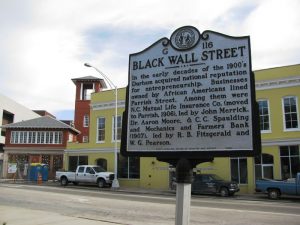The next stop on the Diverse Communities bus tour Jessica and I went on was Parrish Street, where several African American businesses originated and prospered in the early 20th century. Known as “Black Wall Street”, several African American operated enterprises started on Parrish Street, such as the North Carolina Mutual Life Insurance Company (founded in 1898) and Mechanics & Farmers Bank. (founded in 1908).
This vibrant and thriving area was unfortunately decimated – along with other businesses and communities – with the creation of Highway 147 along with numerous other factors. While this did not completely eradicate black enterprise in Durham – NC Mutual and M&F are still thriving – it did physically destroy a significant part of the black neighborhood and in turn, an important part of history.

Mr. Reginald Jones, who works with the Parrish Street Project, talked with us about seeking to revitalize the Parrish Street area. The goal is to commemorate the important legacy of Black Wall street while attracting new businesses to the area to encourage economic revitalization.
Echoing Jessica’s sentiments in an earlier post, it was interesting for the two of us as archivists to be involved in this conversation. We are generally concerned with the preservation of history. It’s important to think about Parrish Street’s heritage in the context of urban planning and development. The urban planning students asked compelling questions about working with the community in order when planning any sort of redevelopment or conceiving any project in a neighborhood. The importance of preserving and celebrating the cultural heritage of a particular area was not lost in the conversation of burgeoning neighborhood development.
The SHC has a number of collections that relate to black owned businesses on Parrish Street and throughout the South. One example is the William Jesse Kennedy Papers, who was the fifth president of NC Mutual Life Insurance.

Several other collections contain materials relating to Mechanics & Farmers Bank, such as the Floyd B. McKissick Papers and the Southern Oral History Program interview with Howard Lee, which describes his interactions with former M&FB president John Wheeler.
Additionally, there are numerous SOHP interviews with former employees of NC Mutual such as former president Asa Spaulding. (Note: There are three interviews with Mr. Spaulding in all).

Bloggers Note:
The term “Black Wall Street” was used in other areas of the country where African American businesses and communities prospered. One of the most well know examples was the Black Wall Street in Tulsa, Oklahoma, in the Greenwood community. This thriving community was all but destroyed in the Tulsa Race Riot of 1921. (http://en.wikipedia.org/wiki/Greenwood,_Tulsa,_Oklahoma).
The Greenwood Community Center (http://greenwoodculturalcenter.com/) includes a virtual tour of the neighborhood as well as maps of areas where the riot struck.
So that is the reason why all progressive sites where called Wall.. LOL should know that!
The revitalization of downtown Durham is so important to the area. It’s great to see a mix of traditional companies along with the new information companies moving in. NC Mutual is such an important company historically, and I believe they can play a bigger role in life insurance to come.
Thanks for your comment. I, too, hope that NC Mutual will continue to serve Durham for many many years to come.
Minor quibble, but Black Wall Street was not decimated. The object of the clause “[t]his vibrant and thriving area” is Hayti, unmentioned in this article. Hayti was the black section of Durham that spread south and east from the main city core. When NC-147 was built it cut through a portion of the black business district and surrounding residential area, but Urban Renewal, and not specifically the highway, was responsible for the levelling of much of Hayti.
Parrish Street – in the middle to Durham – on the other hand, was untouched by the highway project. The street was geographically divided from the Hayti area by several blocks.
Check out the before and after aerial photographs on the blog, Endagered Durham: http://endangereddurham.blogspot.com/2008/10/hayti-overview.html
Andrew,
Thanks for pointing this out. You’re right, our description of the area was imprecise. Black Wall Street proper is a single street, Parrish Street, while historic Hayti is the larger residential, cultural, and business area nearby. This is an important distinction.
Thanks, also, for pointing our readers to Endangered Durham. Gary and his many readers and contributors have provided some really amazing information on the subject of Hayti.
If anyone out there is interested at all in Durham history or historic preservation, E.D. is the place to go.
“Diverse Communities Bus Tour of Historic Durham: Black Wall Street”
Cool post!
“Diverse Communities Bus Tour of Historic Durham: Black Wall Street”
Nice topic
Mr. Reginald i hope you can give me more in pabrik tas
Nice article, i hope my konveksi tas can with your post